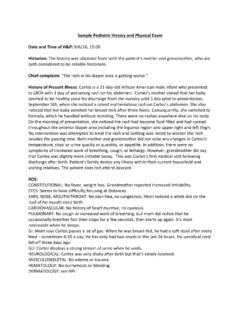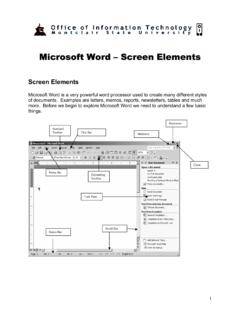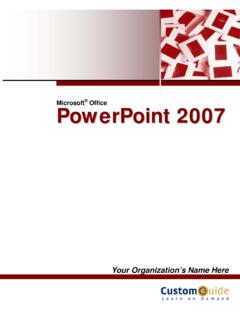Transcription of MICROSOFT WORD FUNCTIONS: DESCRIPTIONS AND …
1 Page 1. MICROSOFT WORD FUNCTIONS: DESCRIPTIONS AND INSTRUCTIONS. REVEAL CODES. Reveal codes is a basic function in Word that enables the writer to see codes displayed in the text of a document. As with any command on a tool ribbon, if the icon is highlighted in orange, it is toggled on; if it is not orange, it is toggled off. Codes displayed when Reveal Code icon is on include: a partially raised dot between characters indicates a space a paragraph' icon at the end of a line indicates a hard return a dotted line with Page Break or Section Break indicates a break between pages or sections an arrow preceding text reveals the presence of a tab The hard return/paragraph'. icon on the Home Ribbon in Word can be toggled off or on to reveal code. Reveal Codes icon toggled ON. Example of use of Reveal Codes Some inexperienced writers do two things that are unacceptable in professional writing: First, writers insert spaces to create an indent rather than inserting a tab Second, writers use hard returns to carry a cursor to a new page rather than inserting a page or section break.
2 The following screen shot (with Reveal Codes ON) displays the difference between a tab (properly used to indent a paragraph and spaces (not for creating an indent). the difference between hard returns and a page break (which is used to break a page for new content that is not wrapping text' which always flows to create a new page). the dots between characters that indicate a space. Developed by Gail Spake for NSG840 Dissemination Course Updated April 18, 2011. Page 2. PAGE BREAKS VS. SECTION BREAKS. Page Break After configuring a Personal Toolbar according to Gail Spake's instructions (available on CON ORGS. Training and Software web site), there will be two icons that will introduce breaks' to a page: an ordinary page break icon (useful for common page breaks) and a page/section break icon (necessary to introduce a section break). Writers often need to introduce a page break; the ordinary page break icon lets you do this in one key stroke. PERSONAL TOOLBAR. Ordinary Page Break icon (note there is no drop down arrow next to this icon.))
3 With Reveal Codes' turned on (so that you can see hard returns and other formatting features displayed in your document), a page break appears beneath the page's contents (as shown in this screen shot): Section Break The Page/Section Break icon has a drop-down arrow next to it (shown in screen shot that follows this one). The drop down arrow next to this icon will open a box that allows you to insert a section break into your document. Page/Section Break icon (note there is a drop down arrow next to this icon. PERSONAL TOOLBAR: Page/Section Break Icon Page/Section break dialog box shown on next page . Developed by Gail Spake for NSG840 Dissemination Course Updated April 18, 2011. Page 3. Page/Section Break dialog box with Section Break on Next Page' highlighted. Section break functions described on next page . Developed by Gail Spake for NSG840 Dissemination Course Updated April 18, 2011. Page 4. Section Break Functions Introducing a new section enables different attributes to be applied to the pages that distinguish it from pages in a previous section.)
4 Attributes can be applied to a new section; , page layout can introduce landscape orientation for a page in the new section . after which another new section can be introduced so that the document proceeds in portrait orientation. Sections can remain linked, where certain attributes will continue from section to section; , page numbering. Sections can be unlinked by toggling off the Link to Previous icon in the Design ribbon (which appears if you place your cursor inside a header or footer). This function is useful, if, for instance, you want to include something in a header (a running header). that is not in a previous section, or if you want to change the type of page numbering ( , from lower case roman numerals in front matter of a document to Arabic numbering in the body of a document. Design Ribbon Link to Previous: Enables you to disconnect headers/footers from attributes of header/footer from previous section. Note that after Section Break, the section numbers change.)
5 It is possible, in a new section, to change attributes of the pages in the following section; , you can make the new section have different headers/footers or change to Developed by Gail Spake for NSG840 Dissemination Course Updated April 18, 2011. Page 5. APPLYING OR REMOVING EXTRA SPACING TO TEXT. There are occasions when writers would like to change spacing for text. Most commonly, this attribute is applied to enforce single or double space positioning of text. There is an icon on the Word Home ribbon that enables the writer to alter spacing in various ways. It is important to have control of spacing in order to meet journal guideline requirements. Some writers submit documents for review without awareness that certain inappropriate spacing attributes are applied to text. The following screen shots demonstrate the function of the Line Spacing Options icon and dialog box. 1. ON the Home Ribbon in the Paragraph tools set there is an icon with up-and-down facing arrows to the left of a series of horizontal lines that has a down-facing arrow; this down-facing arrow has an option that activates the Line Spacing Options dialog box as shown in the following screen shot.
6 Line Spacing Options Link Paragraph dialog box for line spacing functions described on next page . Developed by Gail Spake for NSG840 Dissemination Course Updated April 18, 2011. Page 6. 2. Clicking the Line Spacing Options link will activate the Paragraph dialog box. In this dialog box, various fields enable the writer to modify spacing attributes, including adding space before or after text [NOTE: if one of these is set to Auto as shown in the After' box under Spacing below text will not adhere to Single Spacing.']. setting a hanging indent [NOTE: this feature is helpful if the writer is manually formatting a reference list.]. setting global Line Spacing attributes to text; , single space; pts. space; double space; etc. Setting hanging indents Avoid Auto'. setting Paragraph Dialog Box Developed by Gail Spake for NSG840 Dissemination Course Updated April 18, 2011. Page 7. RULER IN MICROSOFT WORD DOCUMENTS. AND TAB FUNCTIONS. The frame above documents in MICROSOFT Word will display (or hide) a ruler; the arrow in the box on the right of the screen shot below shows the toggle switch to turn the ruler on or off, and the box on the left indicates the TAB' setting.
7 Ruler, Displayed above a Document in Word Ruler Functions Adjust margins for text. The little square and triangular sliders on either end of the tool bar will adjust margins for text. Blocks of text can be highlighted and special margins applied to the block, or if a specific margin setting is applied to the entire document ( , inch left and right margins) the sliders will adjust to the margins automatically. Hanging indents. The sliders on the left will adjust themselves automatically if text is set for hanging indents; , when bullets or numbering is applied to text and the text that wraps must automatically indent after the first line. (This function can be observed with Reveal Codes activated.). Inner and outer margins. The inner margins of a document show on the ruler as white; the blue to the left and right of the sliders is the outer margin. (Text and graphics should never protrude beyond the white space in the ruler.). Set Tab Type. There is a box to the left of the ruler that enables the writer to set various types of tabs that can be placed in the ruler.
8 The tab shown in the display above is a left margin tab, meaning text will align to the left wherever the tab it placed. To select different types of tabs, click the tab set box repeatedly to select from the options: left alignment, right alignment, center, etc. Place a Tab on Ruler. To place a tab on the ruler, first select the type of tab and then click the cursor in the ruler; the tab can be dragged to different points on the ruler. By clicking on the tab mark on the ruler and dragging the tab down, it can be pulled off (deleted) from the ruler. Default Tab Settings. Where no tab mark is shown on the ruler, tab stops are assumed to be set at every .5 . so that tabs inserted into text, or indent commands will proceed at .5 intervals. Center within margins. In order to center content correctly in a document, the sliders must be positioned at the page's margins; if any of the sliders is indented inside the margin settings applied to the entire document, the centered' text will be pushed inward to the extent that the slider is positioned away from the standard page margin.
9 Advanced tab settings. The type and placement of tabs on the ruler can affect other functions in Word, such as the function of leader dots to proceed to page numbers in a table of contents. Advanced tab settings can be activated or defined by clicking the drop down arrow in the lower right corner of the Paragraph tool box in the Home ribbon, and then clicking the Tabs' link in the Paragraph Toolbox Dialog Box. Developed by Gail Spake for NSG840 Dissemination Course Updated April 18, 2011. Page 8. APPLYING FORMAT ATTRIBUTES (OR STYLING) TEXT OR OBJECTS. Format: Styled Text and Content Attributes Styled attributes (format) can be applied to text or graphics in Word. The most familiar styled attributes would be Bold, Underline, Font Color, Italics, or superscript and subscript. There are icons on the Word Home ribbon that enable these attributes to be activated and applied to text or graphics. Remember, if an icon is orange in the ribbon, it is toggled on; if it is not orange, it is off.
10 Format Painter The Format Painter icon (appears as a paintbrush) on the Home ribbon allows the writer to duplicate' a formatting attribute onto other content. For instance, if several words must be italicized at different positions in text, the writer can position the cursor anywhere in the text with the desired format (in this case italicized text). and then double click the Format Painter icon. By double clicking the icon, it will STAY on so that the painter can be used repeatedly. With the Format Painter icon ON, the writer can highlight various text blocks or words and each highlighted set of text will pick up' the format that was on the text where the cursor was positioned earlier. This feature can be helpful when it's beneficial to paint' Bold formatting onto a succession of headings. Developed by Gail Spake for NSG840 Dissemination Course Updated April 18, 2011. Page 9. RIBBONS IN MICROSOFT WORD: VARIOUS TOOL SETS. The list below describes some very basic tools and functions that are positioned on various ribbons in MICROSOFT Word.











